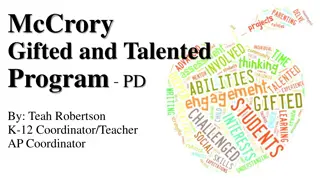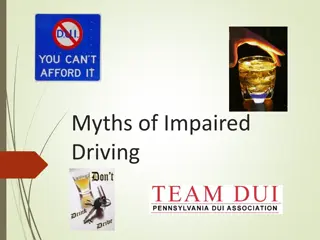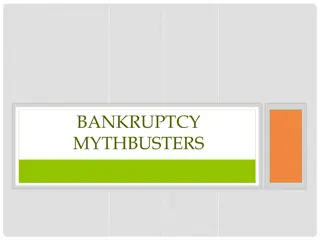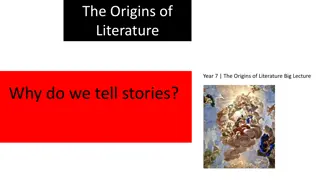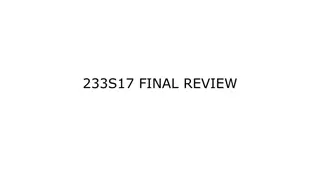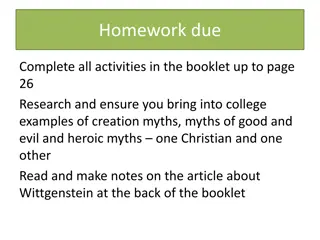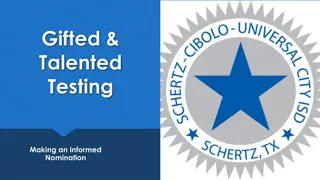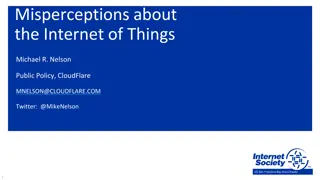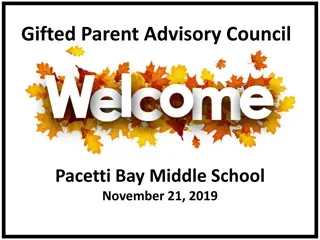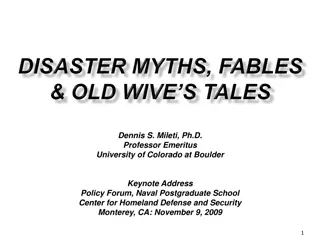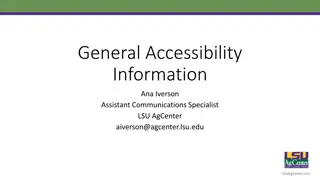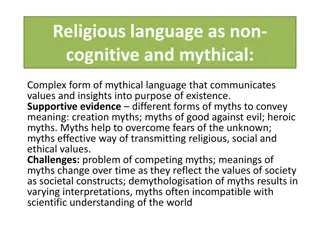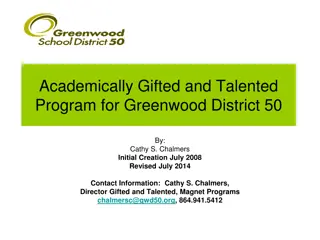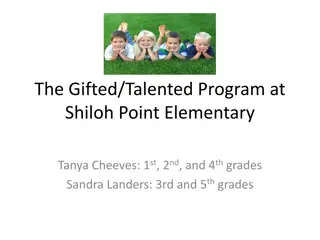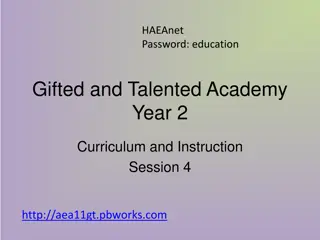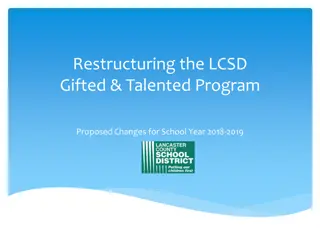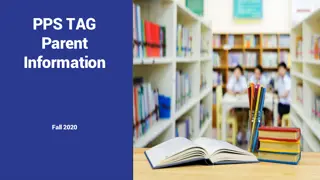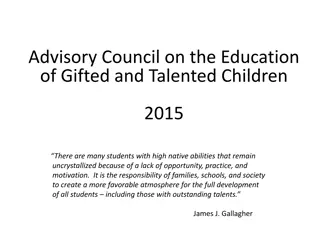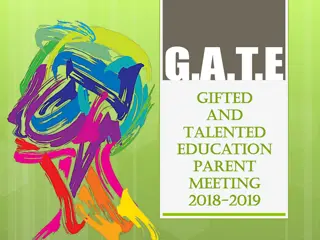Debunking Myths About Gifted Children
Debunking the common myths surrounding gifted children, this presentation challenges misconceptions and emphasizes the importance of effort, growth mindset, and individualized support in nurturing their talents. It showcases insights from experts in the field and addresses key misconceptions about gifted education.
Download Presentation

Please find below an Image/Link to download the presentation.
The content on the website is provided AS IS for your information and personal use only. It may not be sold, licensed, or shared on other websites without obtaining consent from the author. Download presentation by click this link. If you encounter any issues during the download, it is possible that the publisher has removed the file from their server.
E N D
Presentation Transcript
Debunking the Myths about Gifted Children: They Really Are Exceptional Children Tracy Inman and Julia Roberts The Center for Gifted Studies at Western Kentucky University tracy.inman@wku.edu julia.roberts@wku.edu
If during the first five or six years of school, a child earns good grades and high praise without having to make much effort, what are all the things he doesn t learn that most children learn by third grade?
1. Gifted children thrive with more work. False
ACT data show that fewer than two in ten eighth graders are on target to be ready for college- level work by the time they graduate from high school. The Forgotten Middle, 2009
How a person views the origin of talent is important! If you see talent as something you demonstrate Fixed Mindset If you see talent as something to be developed Growth Mindset Carol Dweck, Mindset: The New Psychology of Success
Success is about being your best self, not about being better than others; failure is an opportunity, not a condemnation; effort is the key to success. (Dweck, 2007, p. 44).
2. Allowing a gifted child to tutor another child is usually a very effective service option. You really learn something when you teach it. False
3. Just because a child is gifted in one area does not mean he is gifted in all areas. True
4. Do not expect gifted students to be model students. True
5. Gifted students are not at risk. If they really have high ability, they can get by on their own. False
6. Giftedness can easily be measured by intelligence tests and tests of achievement. False
7. A good teacher can teach any student, because if good teaching is used, that is all that is needed. False
8. Even if the curriculum is accelerated for all students, services are still needed for gifted learners. True
Service Options Acceleration Advanced Placement and Honors Courses Collaborative Teaching and Consultation Services Competitions Concurrent College Enrollment/Dual Credit Differentiated Study Experiences for Individuals and Cluster Groups in the Regular Classroom Distance Learning/Internet Courses Enrichment Service During the School Day Independent Study International Baccalaureate Magnet Schools/ Self- contained Classrooms Mentorships Seminars Special Counseling Services: Group and Individual Summer Programs Travel Study Options
Many states have their own definitions/categories of giftedness. Kentucky Law (KRS 157.200 l n) includes five categories of gifted within exceptional students: General Intellectual Specific Academic Leadership Creativity Visual and/or Performing Arts
10. Most children suffer emotionally and socially when grade accelerated. False
How do we know this? A Nation Deceived: How Schools Hold Back America s Brightest Students (2004) www.accelerationinstitute.org/nation_deceived/ A Nation Empowered: Evidence Trumps the Excuses Holding Back America s Brightest Students (2015) www.accelerationinstitute.org/nation_empowered/Institute for Research and Policy Acceleration The Connie Belin & Jacqueline N. Blank International Center for Gifted Education and Development, The University of Iowa www.accelerationinstitute.org/
11. The brightest students tend to make the lowest achievement gains in school. True
High Achieving Students in the Era of NCLBThomas B. Fordham Institute While the nation s lowest-achieving youngsters made rapid gains from 2000 to 2007, the performance of top students was languid. Children at the tenth percentile of achievement (the bottom 10 percent of students) have shown solid progress in fourth-grade reading and math and eighth-grade math since 2000, but those at the 90th percentile (the top 10 percent) have made minimal gains.
Talent on the Sidelines: Excellence Gaps and America s Persistent Talent Underclass Fourth Graders Low income Black Hispanic ELL Eighth Graders Low income Black Hispanic ELL 1.8% 1.1% 1.9% .6% 2.5% 1.5% 2.7% .5% In Grades 4 and 8, a much smaller percentage of low- income, minority, and English-Language learner students score at the Advanced Level on NAEP in math.
12. Gifted students are needed in all classes so that students do not lack positive role models for academic and social leadership. False
References Assouline, S. G., Colangelo, N., & VanTassel-Baska, J. (2015). A nation empowered: Evidence trumps the excuses holding back America s brightest students (Vol. 1). Iowa City: University of Iowa, The Connie Belin & Jacqueline N. Blank International Center for Gifted Education and Development. Retrieved from http://www.accelerationinstitute.org/ Nation_Empowered/ Colangelo, N., Assouline, S. G., & Gross, M. U. M. (2004). A nation deceived: How schools hold back America s brightest students (Vol. 1). The Templeton national report on acceleration. Iowa City: University of Iowa. Cross, T. L., & Betts, G. (2015). Guest forward. In S. G. Assouline, N. Colangelo, & J. VanTassel-Baska (Eds). A nation empowered: Evidence trumps the excuses holding back America s brightest students (Vol. 1) (p. vii). Iowa City: University of Iowa, The Connie Belin & Jacqueline N. Blank International Center for Gifted Education and Development. DeLacy, M. (2004, June 23). The No Child law s biggest victims? An answer may surprise. Education Week, 23(41), 40. Every Student Succeeds Act. Pub. L. 114-95. (2015) Inman, T. F., & Kirchner, J. (2016). Parenting gifted children 101: An introduction to gifted kids and their needs. Waco, TX: Prufrock Press. (Answers to questions 2, 4, 5, 6, 9, 10, 11, and 12 come straight from this source.) Jensen, E. (2006). Enriching the brain: How to maximize every learner s potential. San Francisco, CA: John Wiley & Sons. Loveless, T., Farkas, S., & Duffett, A. (2008). High-achieving students in the era of NCLB. Washington, DC: Thomas B. Fordham Institute. McCoach, B., Rambo, K. E., & Welsh, M. (20120). Assessing the growth of gifted students. Gifted Child Quarterly, (57)1. McCombs, B. (2010). Developing responsible and autonomous learners: A key to motivating students. American Psychological Association. Retrieved from http://www.apa.org/ education/ k12/learners.aspx Moon, S. (2009). Myth 15: High-ability students don t face problems and challenges. Demythologizing gifted education. [Special issue.] Gifted Child Quarterly, 53(4), 274-276. National Association for Gifted Children. (2010). Pre-k-grade 12 gifted programming standards. Retrieved from http://www.nagc.org/resources-publications/resources/national-standards-gifted-and-talented-education/pre-k-grade-12 Rimm, S. B. (2008). Why bright kids get poor grades (3rd Ed.). Tucson, AZ: Great Potential Press. Roberts, J. L., & Inman, T. F. (2009, June). Advocacy column: Communicating powerful and timely advocacy messages. Parenting for High Potential, 9-11. Ross, P. O. (1993). National excellence: A case for developing America s talent. Washington, DC: U.S. Government Printing Office. Schunk, D.H. (1987). Peer models and children's behavioral change. Review of Educational Research, 57, 149-174. Wai, J. (2015). Long-term effects of educational acceleration In S. G. Assouline, N. Colangelo, & J. VanTassel-Baska (Eds.), A nation empowered: Evidence trumps the excuses holding back America s brightest students (Vol. 1) (pp. 73-84). Iowa City: University of Iowa, The Connie Belin & Jacqueline N. Blank International Center for Gifted Education and Development. Worrell, F. (2009). Myth 4: Single test score or indicator tells us all we need to know about giftedness. Demythologizing gifted education. [Special issue.] Gifted Child Quarterly, 53(4), 242-244.


